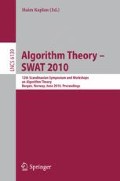Abstract
A mobile robot represented by a point moving in the plane has to explore an unknown flat terrain with impassable obstacles. Both the terrain and the obstacles are modeled as arbitrary polygons. We consider two scenarios: the unlimited vision, when the robot situated at a point p of the terrain explores (sees) all points q of the terrain for which the segment pq belongs to the terrain, and the limited vision, when we require additionally that the distance between p and q be at most 1. All points of the terrain (except obstacles) have to be explored and the performance of an exploration algorithm, called its complexity, is measured by the length of the trajectory of the robot.
For unlimited vision we show an exploration algorithm with complexity \(O(P+D\sqrt{k})\), where P is the total perimeter of the terrain (including perimeters of obstacles), D is the diameter of the convex hull of the terrain, and k is the number of obstacles. We do not assume knowledge of these parameters. We also prove a matching lower bound showing that the above complexity is optimal, even if the terrain is known to the robot. For limited vision we show exploration algorithms with complexity \(O(P+A+\sqrt{Ak})\), where A is the area of the terrain (excluding obstacles). Our algorithms work either for arbitrary terrains, if one of the parameters A or k is known, or for c-fat terrains, where c is any constant (unknown to the robot) and no additional knowledge is assumed. (A terrain \({\mathcal T}\) with obstacles is c-fat if R/r ≤ c, where R is the radius of the smallest disc containing \({\mathcal T}\) and r is the radius of the largest disc contained in \({\mathcal T}\).) We also prove a matching lower bound \(\Omega(P+A+\sqrt{Ak})\) on the complexity of exploration for limited vision, even if the terrain is known to the robot.
Access this chapter
Tax calculation will be finalised at checkout
Purchases are for personal use only
Preview
Unable to display preview. Download preview PDF.
References
Albers, S., Kursawe, K., Schuierer, S.: Exploring unknown environments with obstacles. Algorithmica 32, 123–143 (2002)
Bandyopadhyay, T., Liu, Z., Ang, M.H., Seah, W.K.G.: Visibility-based exploration in unknown environment containing structured obstacles. Advanced Robotics, 484–491 (2005)
Bar-Eli, E., Berman, P., Fiat, A., Yan, R.: On-line navigation in a room. Journal of Algorithms 17, 319–341 (1994)
Berman, P., Blum, A., Fiat, A., Karloff, H., Rosen, A., Saks, M.: Randomized robot navigation algorithms. In: Proc. 7th ACM-SIAM Symp. on Discrete Algorithms, pp. 74–84 (1996)
Blum, A., Raghavan, P., Schieber, B.: Navigating in unfamiliar geometric terrain. SIAM Journal on Computing 26, 110–137 (1997)
Cuperlier, N., Quoy, M., Giovanangelli, C.: Navigation and planning in an unknown environment using vision and a cognitive map. In: Proc. Workshop: Reasoning with Uncertainty in Robotics, pp. 48–53 (2005)
Deng, X., Kameda, T., Papadimitriou, C.H.: How to learn an unknown environment. In: Proc. 32nd Symp. on Foundations of Comp. Sci. (FOCS 1991), pp. 298–303 (1991)
Deng, X., Kameda, T., Papadimitriou, C.H.: How to learn an unknown environment I: the rectilinear case. Journal of the ACM 45, 215–245 (1998)
Gabriely, Y., Rimon, E.: Spanning-tree based coverage of continuous areas by a mobile robot. In: Proc. Int. Conf. of Robotics and Automaton (ICRA 2001), pp. 1927–1933 (2001)
Gabriely, Y., Rimon, E.: Competitive on-line coverage of grid environments by a mobile robot. Computational Geometry: Theory and Applications 24(3), 197–224 (2003)
Ghosh, S.K., Burdick, J.W., Bhattacharya, A., Sarkar, S.: Online algorithms with discrete visibility - exploring unknown polygonal environments. Robotics & Automation Magazine 15, 67–76 (2008)
Hoffmann, F., Icking, C., Klein, R., Kriegel, K.: The polygon exploration problem. SIAM J. Comput. 31, 577–600 (2001)
Icking, C., Kamphans, T., Klein, R., Langetepe, E.: Exploring an unknown cellular environment. In: Abstracts of the 16th European Workshop on Computational Geometry, pp. 140–143 (2000)
Kolenderska, A., Kosowski, A., Małafiejski, M., Żyliński, P.: An Improved Strategy for Exploring a Grid Polygon. In: SIROCCO, pp. 222–236 (2009)
Kalyanasundaram, B., Pruhs, K.: A Competitive Analysis of Algorithms for Searching Unknown Scenes. Comput. Geom. 3, 139–155 (1993)
Ntafos, S.: Watchman routes under limited visibility. Comput. Geom. Theory Appl. 1, 149–170 (1992)
Osserman, R.: The isoperimetric inequality. Bull. Amer. Math. Soc. 84, 1182–1238 (1978)
Papadimitriou, C.H., Yannakakis, M.: Shortest paths without a map. Theor. Comput. Sci. 84, 127–150 (1991)
Sim, R., Little, J.J.: Autonomous vision-based exploration and mapping using hybrid maps and Rao-Blackwellised particle filters. Intelligent Robots and Systems, 2082–2089 (2006)
Tovar, B., Murrieta-Cid, R., Lavalle, S.M.: Distance-optimal navigation in an unknown environment without sensing distances. IEEE Transactions on Robotics 23, 506–518 (2007)
Author information
Authors and Affiliations
Editor information
Editors and Affiliations
Rights and permissions
Copyright information
© 2010 Springer-Verlag Berlin Heidelberg
About this paper
Cite this paper
Czyzowicz, J., Ilcinkas, D., Labourel, A., Pelc, A. (2010). Optimal Exploration of Terrains with Obstacles. In: Kaplan, H. (eds) Algorithm Theory - SWAT 2010. SWAT 2010. Lecture Notes in Computer Science, vol 6139. Springer, Berlin, Heidelberg. https://doi.org/10.1007/978-3-642-13731-0_1
Download citation
DOI: https://doi.org/10.1007/978-3-642-13731-0_1
Publisher Name: Springer, Berlin, Heidelberg
Print ISBN: 978-3-642-13730-3
Online ISBN: 978-3-642-13731-0
eBook Packages: Computer ScienceComputer Science (R0)

